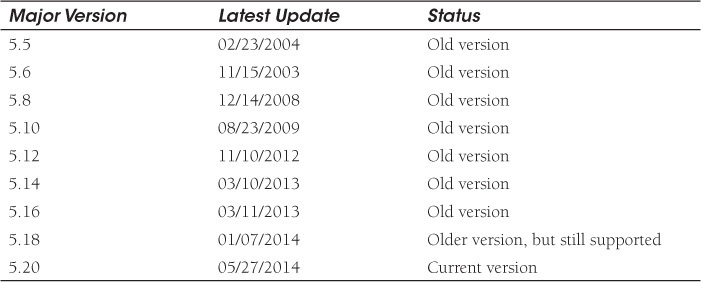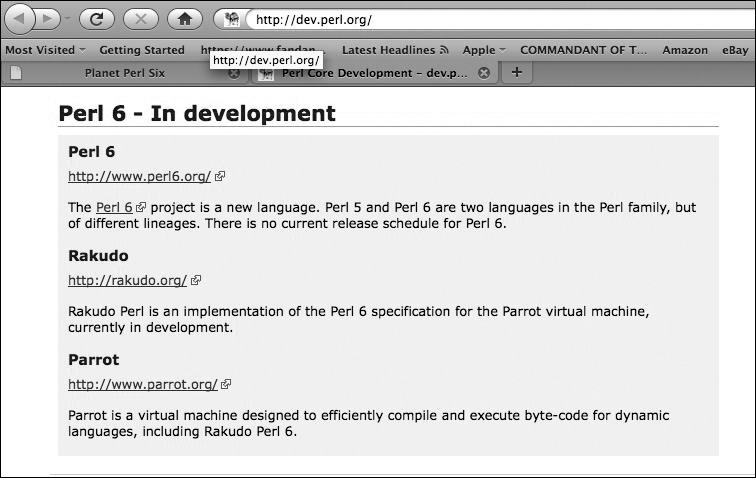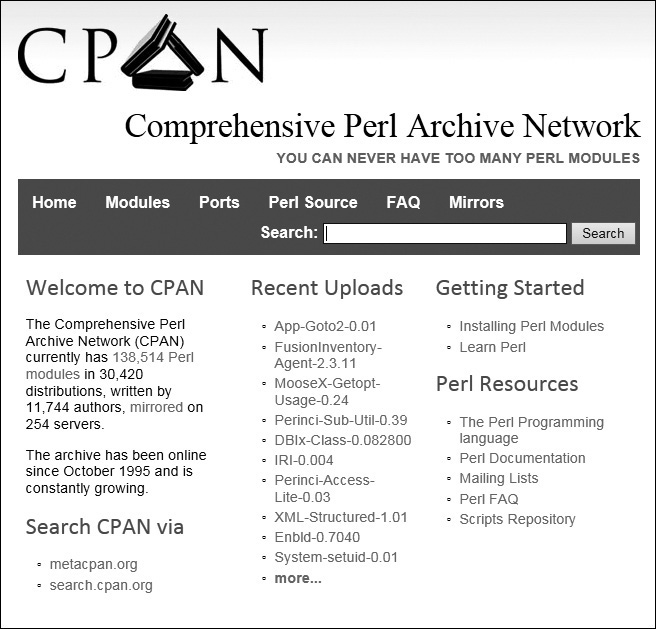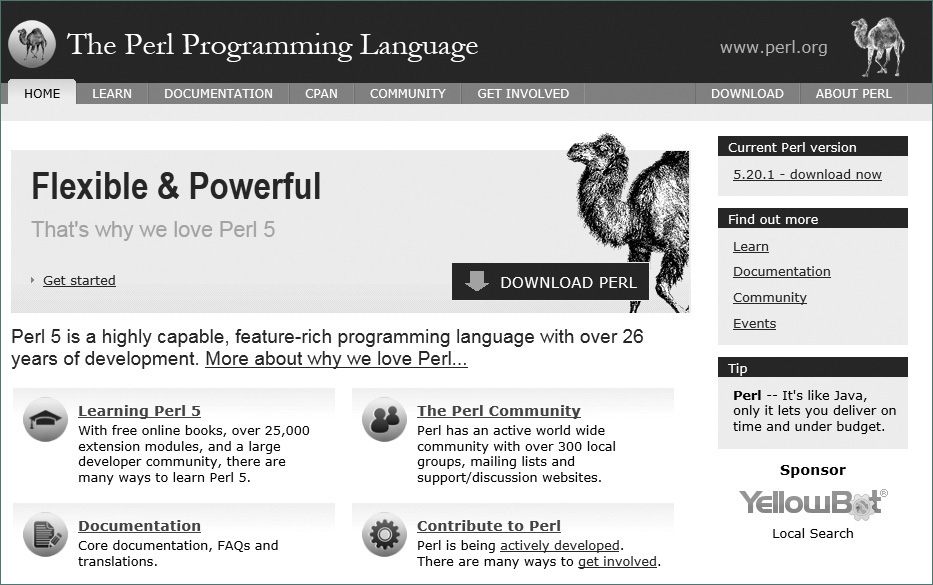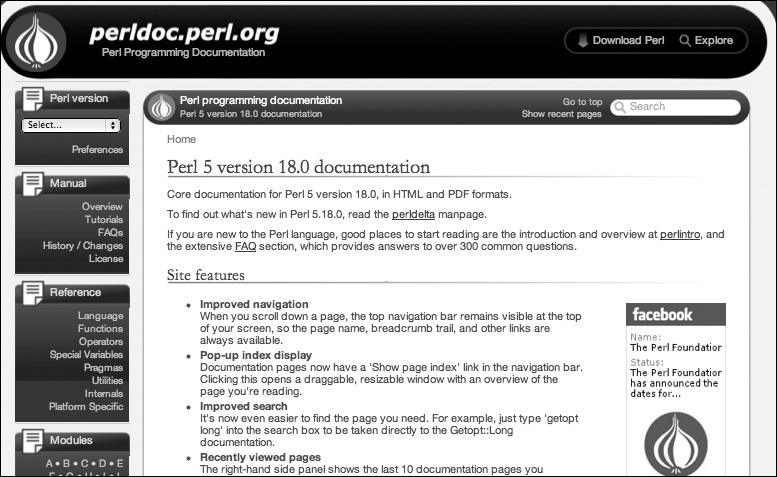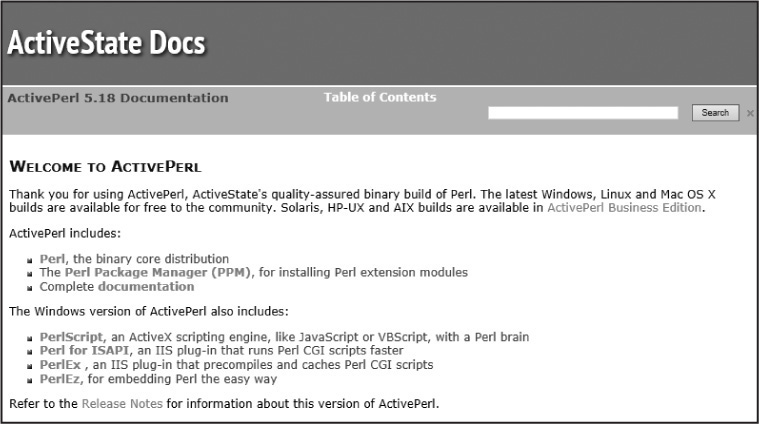Chapter 1. The Practical Extraction and Report Language

1.1 What Is Perl?
“Laziness, impatience, and hubris. Great Perl programmers embrace those virtues.”
—Larry Wall
Perl is an all-purpose, open-source (free software) interpreted language maintained and enhanced by a core development team called the Perl Porters. It is used primarily as a scripting language and runs on a number of platforms. Although initially designed for the UNIX operating system, Perl is renowned for its portability and now comes bundled with most operating systems, including RedHat Linux, Solaris, FreeBSD, Macintosh, and more. Due to its versatility, Perl is often referred to as the Swiss Army Knife of programming languages.

Larry Wall wrote the Perl language to manage log files and reports scattered over the network. According to Wikipedia.org, Perl was originally named “Pearl,” but when Larry Wall realized that PEARL was another programing language that had been around since 1977, he simply dropped the “a” and the name became “Perl.” Perl was later dubbed the Practical Extraction and Report Language, and by some, it is referred to as the Pathologically Eclectic Rubbish Lister. Perl is really much more than a practical reporting language or eclectic rubbish lister, as you’ll soon see. Perl makes programming easy, flexible, and fast. Those who use it, love it. And those who use it range from experienced programmers to novices with little computer background at all. The number of users continues to grow at a phenomenal rate.1
1. Perl is spelled “Perl” when referring to the language, and “perl” when referring to the interpreter.
Perl’s heritage is UNIX. Perl scripts are functionally similar to UNIX awk, sed, shell scripts, and C programs. Shell scripts consist primarily of UNIX commands; Perl scripts do not. Whereas sed and awk are used to edit and report on files, Perl does not require a file in order to function. Whereas C has none of the pattern matching and wildcard metacharacters of the shells, sed, and awk, Perl has an extended set of characters. Perl was originally written to manipulate text in files, extract data from files, and write reports, but through continued development, it can manipulate processes, perform networking tasks, process Web pages, talk to databases, and analyze scientific data. Perl is truly the Swiss Army Knife of programming languages; there is a tool for everyone.
The examples in this book were created on systems running Solaris, Linux, Macintosh, UNIX, and Win32.
Perl is often associated with a camel symbol, a trademark of O’Reilly Media, which published the first book on Perl called Programming Perl by Larry Wall and Randal Schwartz (also referred to as “the Camel Book”).

1.2 What Is an Interpreted Language?
To write Perl programs, you need two things: a text editor and a perl interpreter, which you can download very quickly from any number of Web sites, including perl.org, cpan.org, and activestate.com. Unlike with compiled languages, such as C++ and Java, you do not need to first compile your program into machine-readable code before executing it. The perl interpreter does it all; it handles the compilation, interpretation, and execution of your program. Advantages of using an interpreted language such as Perl is that it runs on almost every platform, is relatively easy to learn, and is very fast and flexible.
Languages such as Python, JavaScript, and Perl are interpreted languages that use an intermediate representation, which combines both compilation and interpretation. It compiles the user’s code into an internal condensed format called bytecode, or threaded code, which is then executed by the interpreter. When you run Perl programs, you need to be aware of two phases: the compilation phase, and then the run phase where you will see the program results. If you have syntax errors, such as a misspelled keyword or a missing quote, the compiler will send an error. If you pass the compiler phase, you could have other problems when the program starts running. If you pass both of these phases, you will probably start working on formatting to make the output look nicer, improving the program to make it more efficient, and so forth.
The interpreter also provides a number of command-line switches (options) to control its behavior. There are switches to check syntax, send warnings, loop through files, execute statements, turn on the debugger, and so forth. You will learn about these options throughout the following chapters.
1.3 Who Uses Perl?
Because Perl has built-in functions to easily manipulate processes and files, and because Perl is portable (that is, it can run on a number of different platforms), it is especially popular with system administrators, who often oversee one or more systems of different types. The phenomenal growth of the World Wide Web greatly increased interest in Perl, which was the most popular language for writing CGI scripts to generate dynamic Web pages. Even today, with the advent of other languages focused on processing Web pages, such as Ruby, Node, and ASP.net, Perl continues its popularity with system and database administrators, scientists, geneticists, and anyone who has a need to collect data from files and manipulate it.
Anyone can use Perl, but it is easier to learn if you are already experienced in writing UNIX shell scripts or languages derived from C, such as C++ and Java. For these people, the migration to Perl will be relatively easy. For those who have little programming experience, the learning curve might be a little steeper, but after learning Perl, there may be no reason to ever use anything else.
If you are familiar with UNIX utilities such as awk, grep, sed, and tr, you know that they don’t share the same syntax; the options and arguments are handled differently, and the rules change from one utility to the other. If you are a shell programmer, you usually go through the grueling task of learning a variety of utilities, shell metacharacters, regular expression metacharacters, quotes, more quotes, and so forth. Also, shell programs are limited and slow. To perform more complex mathematical tasks and to handle interprocess communication and binary data, for example, you may have to turn to a higher-level language, such as C, C++, or Java. If you know C, you also know that searching for patterns in files and interfacing with the operating system to process files and execute commands are not always easy tasks.
Perl integrates the best features of shell programming, C, and the UNIX utilities awk, grep, sed, and tr. Because it is fast and not limited to chunks of data of a particular size, many system administrators and database administrators have switched from the traditional shell scripting to Perl. C++ and Java programmers can enjoy the object-oriented features added in Perl 5, including the ability to create reusable, extensible modules. Now, with Perl you can generate Perl in other languages, and you can embed other languages in Perl. There is something for everyone who uses Perl, and for every task. As Larry Wall says, “There’s more than one way to do it.”2
2. Larry Wall, “Diligence, Patience, and Humility,” http://www.oreilly.com/catalog/opensources/book/larry.html.
You don’t have to know everything about Perl to start writing scripts. You don’t even have to be a programmer. This book will help you get a good jump-start, and you will quickly see some of its many capabilities and advantages. Then you can decide how far you want to go with Perl. If nothing else, Perl is fun!
1.3.1 Which Perl?
Perl has been through a number of revisions. The last version of Perl 4 was Perl 4, patchlevel 36 (Perl 4.036), released in 1992, making it ancient. Perl 5.000 (also ancient), introduced in fall 1994, was a complete rewrite of the Perl source code that optimized the language and introduced objects and many other features. Despite these changes, Perl 5 remains highly compatible with the previous releases. As of this writing, the current stable version of Perl is 5.20, actively maintained by a large group of voluntary contributors listed at www.ohloh.net/p/perl/contributors. Perl 6 is the next generation of another Perl redesign and does not have an official release date. It has new features, but the basic components of the Perl language you learn here will be essentially the same.
From Wikipedia:
Some observers credit the release of Perl 5.10 with the start of the Modern Perl movement. In particular, this phrase describes a style of development which embraces the use of the CPAN, takes advantage of recent developments in the language (see Table 1.1), and is rigorous about creating high-quality code.3
3. Wikipedia.org, “Perl,” http://en.wikipedia.org/wiki/Perl.
1.3.2 What Are Perl 6, Rakudo Perl, and Parrot?
“Perl 5 was my rewrite of Perl. I want Perl 6 to be the community’s rewrite of Perl and of the community.”
—Larry Wall, State of the Onion speech, TPC4
Perl 6 is essentially Perl 5 with many new features. Although they continue to develop in parallel, Perl 6 will not supersede Perl 5. The basic language syntax, features, and purpose will be the same. If you know Perl, you will still know Perl. If you learn Perl from this book, you will be prepared to jump into Perl 6 when it is released. Perl 6 has been described by Perl.org as learning Australian English if you speak American English, rather than trying to switch from English to Chinese.
Rakudo Star, a useful and usable distribution of Perl 6 that runs on the Parrot virtual machine, was recently released in October 2013. To find out more go to http://rakudo.org.
Parrot is a virtual machine designed to efficiently compile and execute bytecode for dynamic languages. Parrot currently hosts a variety of language implementations in various stages of completion, including Tcl, JavaScript, Ruby, Lua, Scheme, PHP, Python, Perl 6, APL, and a .NET bytecode translator.4
4. Parrot Speaks Your Language, http://parrot.org.
To learn more about the latest Perl core development with Perl 6, Rakudo, and Parrot, go to http://dev.perl.org (see Figure 1.1).
And for a biographical sketch of Larry Wall and the history of Perl, go to http://www.softpanorama.org/People/Wall/index.shtml#Perl_history.
1.4 Where to Get Perl
Perl downloading and instructions are available from a number of sources. You can check the following popular sites for a Perl distribution for your computer: cpan.org, perl.org, and activestate.com, and strawberryperl.com.
1.4.1 CPAN (cpan.org)
The primary source for Perl distribution is CPAN, which is available at www.cpan.org (see Figure 1.2). CPAN, the “gateway to all things Perl,” stands for the Comprehensive Perl Archive Network, a Web site that houses all the free Perl material you will ever need, including documentation, FAQs, modules and scripts, binary distributions and source code, and announcements. CPAN is mirrored all over the world, and you can find the nearest mirror at
CPAN is the place you will go to if you want to find modules to help you with your work. The CPAN search engine will let you find modules under a large number of categories. Modules are discussed in Chapter 13, “Modularize It, Package It, and Send It to the Library!”
Go to www.cpan.org/ports to find out more about what’s available for your platform, of which Perl supports more than 100.
1.4.2 Downloads and Other Resources for Perl (perl.org)
The official Perl home page, run by O’Reilly Media, Inc. is www.perl.com, but it seems that everything you will need is found at www.perl.org (see Figure 1.3).
Figure 1.3 The Perl.org Web site.
1.4.3 ActivePerl (activestate.com)
If you want to install Perl quickly and easily, ActivePerl is a complete, self-installing distribution of Perl based on the standard Perl sources for Windows, Mac OS X, Linux, Solaris, AIX, and HP-UX. It is distributed online at the ActiveState site (www.activestate.com). The complete ActivePerl package contains the binary of the core Perl distribution, complete online documentation, and all the essential tools for Perl development, including PPM, a handy perl package manager. This is available at www.activestate.com/activeperl (see Figure 1.4).
1.4.4 What Version Do I Have?
To obtain your Perl version, date the binary version was built, patches, and some copyright information, type the line shown in Example 1.1 (the dollar sign is the shell prompt).
1.5 Perl Documentation
Today, you can find answers to any Perl questions simply by using your favorite search engine or going to the Perl.org Web site. Most Perl distributions also come with full documentation in both HTML and PDF formats.
1.5.1 Where to Find the Most Complete Documentation from Perl
For the most complete documentation, type the Perl function you are looking for in your search engine or just go directly to perldoc.perl.org (see Figure 1.5) for all the complete documentation for any version of Perl.
Figure 1.5 Documentation at perldoc.perl.org.
1.5.2 Perl man Pages
The standard Perl distribution comes with complete online documentation, called man pages, which provide help for all the standard utilities. (The name derives from the UNIX man [manual] pages.) Perl has divided its man pages into categories. If you type the following at your command-line prompt:
man perl
you will get a list of all the sections by category. So, if you want help on how to use Perl’s regular expressions, you would type:
man perlre
and if you want help on subroutines, you would type:
man perlsub
The Perl categories are listed in Table 1.2, with the following sections available only in the online reference manual.
If you are trying to find out how a particular library module works, you can use the perldoc command to get the documentation. (This command will give you documentation for the version of Perl you are currently using, whereas the man pages refer to the system Perl.) For example, if you want to know about the Moose module, type at the command line:
perldoc Moose
and the documentation for the Moose.pm module will be displayed. If you type:
perldoc Carp
the documentation for the Carp.pm module will be displayed.
To get documentation on a specific Perl function, type perldoc -f and the name of the function. For example, to find out about the localtime function, you would execute the following command at your command-line prompt (you may have to set your UNIX/DOS path to execute this program directly):
perldoc -f localtime
localtime EXPR
localtime
Converts a time as returned by the time function to a 9-element
list with the time analyzed for the local time zone. Typically
used as follows:
# 0 1 2 3 4 5 6 7 8
($sec,$min,$hour,$mday,$mon,$year,$wday,$yday,$isdst) =
localtime(time);
<continues>
1.5.3 Online Documentation
ActivePerl provides excellent documentation (from ActiveState.com) when you download Perl from its site. As shown in Figure 1.6, there are links to everything you need to know about Perl.
2. What does Perl stand for?
3. What is the meaning of “open source”?
4. What is the current release?
5. What is Perl used for?
6. What is an interpreted language?
7. Where can you get Perl?
8. What is Strawberry Perl?
9. What is ActivePerl?
10. What is CPAN?
11. Where do you get documentation?
12. How would you find documentation for a specific Perl function?
1.7 What’s Next?
In the next chapter, you will learn how to create basic Perl scripts and execute them. You will learn what goes in a Perl script, and about Perl syntax, statements, and comments. You will learn how to check for syntax errors and how to execute Perl at the command line with a number of Perl options.

